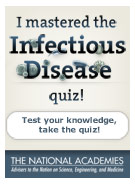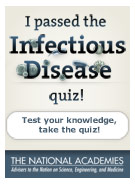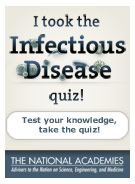
What You Need To Know About Infectious Disease
What do you know about infectious disease?
Each year, how many Americans become infected by what they eat?
-
Sorry, that’s incorrect.
Each year about 76 million Americans—or one in four—become infected by what they eat. Approximately 325,000 are hospitalized. More than 5,000 (14 a day) die.
-
Sorry, that’s incorrect.
Each year about 76 million Americans—or one in four—become infected by what they eat. Approximately 325,000 are hospitalized. More than 5,000 (14 a day) die.
-
Correct!
Each year about 76 million Americans—or one in four—become infected by what they eat. Approximately 325,000 are hospitalized. More than 5,000 (14 a day) die.
Which reproduce the fastest:
-
Sorry, that’s incorrect.
Viruses reproduce the fastest. Humans produce a new generation every 20 years or so; bacteria do it every 20 to 30 minutes, and viruses even faster.
-
Sorry, that’s incorrect.
Viruses reproduce the fastest. Humans produce a new generation every 20 years or so; bacteria do it every 20 to 30 minutes, and viruses even faster.
-
Correct!
Viruses reproduce the fastest. Humans produce a new generation every 20 years or so; bacteria do it every 20 to 30 minutes, and viruses even faster.
About how often is someone in the world newly infected with tuberculosis (TB)?
-
Correct!
Someone in the world is newly infected with tuberculosis (TB) every second. In 2008 there were an estimated 9.4 million new cases of tuberculosis and 1.8 million deaths.The vast majority of TB deaths are in the developing world, and more than half of all deaths occur in Asia.
-
Sorry, that’s incorrect.
Someone in the world is newly infected with tuberculosis (TB) every second. In 2008 there were an estimated 9.4 million new cases of tuberculosis and 1.8 million deaths.The vast majority of TB deaths are in the developing world, and more than half of all deaths occur in Asia.
-
Sorry, that’s incorrect.
Someone in the world is newly infected with tuberculosis (TB) every second. In 2008 there were an estimated 9.4 million new cases of tuberculosis and 1.8 million deaths.The vast majority of TB deaths are in the developing world, and more than half of all deaths occur in Asia.
True or False: Most infectious diseases are not impacted by changes in the environment.
-
Sorry, that’s incorrect.
Most infectious diseases are impacted by changes in the environment. Malaria, dengue, and viral encephalitis infections, for example, are highly sensitive to environmental changes.
-
Correct!
Most infectious diseases are impacted by changes in the environment. Malaria, dengue, and viral encephalitis infections, for example, are highly sensitive to environmental changes.
Which of the following diseases is NOT caused by a virus?
-
Sorry, that’s incorrect.
Tuberculosis is caused by a bacterial infection. Chicken pox, the common cold, and influenza are all caused by viral infections.
-
Sorry, that’s incorrect.
Tuberculosis is caused by a bacterial infection. Chicken pox, the common cold, and influenza are all caused by viral infections.
-
Sorry, that’s incorrect.
Tuberculosis is caused by a bacterial infection. Chicken pox, the common cold, and influenza are all caused by viral infections.
-
Correct!
Tuberculosis is caused by a bacterial infection. Chicken pox, the common cold, and influenza are all caused by viral infections.
Which of the following diseases kills more children worldwide than any other infectious disease?
- Lower respiratory tract infections (including pneumonia)
- HIV/AIDS
- Diarrheal diseases
- Tuberculosis
- Malaria
-
Correct!
Lower respiratory tract infections (including pneumonia) kill more children worldwide than any other infectious disease. Together these diseases are the five leading causes of infectious disease worldwide, accounting for nearly one-fifth of all deaths.
-
Sorry, that’s incorrect.
Lower respiratory tract infections (including pneumonia) kill more children worldwide than any other infectious disease. Together these diseases are the five leading causes of infectious disease worldwide, accounting for nearly one-fifth of all deaths.
-
Sorry, that’s incorrect.
Lower respiratory tract infections (including pneumonia) kill more children worldwide than any other infectious disease. Together these diseases are the five leading causes of infectious disease worldwide, accounting for nearly one-fifth of all deaths.
-
Sorry, that’s incorrect.
Lower respiratory tract infections (including pneumonia) kill more children worldwide than any other infectious disease. Together these diseases are the five leading causes of infectious disease worldwide, accounting for nearly one-fifth of all deaths.
-
Sorry, that’s incorrect.
Lower respiratory tract infections (including pneumonia) kill more children worldwide than any other infectious disease. Together these diseases are the five leading causes of infectious disease worldwide, accounting for nearly one-fifth of all deaths.
How many people in the world do not have access to an adequate water supply?
-
Sorry, that’s incorrect.
Worldwide, 884 million people do not have access to an adequate water supply, and about three times that number lack basic sanitation services. An estimated 2 million deaths a year can be attributed to unsafe water supplies.
-
Sorry, that’s incorrect.
Worldwide, 884 million people do not have access to an adequate water supply, and about three times that number lack basic sanitation services. An estimated 2 million deaths a year can be attributed to unsafe water supplies.
-
Correct!
Worldwide, 884 million people do not have access to an adequate water supply, and about three times that number lack basic sanitation services. An estimated 2 million deaths a year can be attributed to unsafe water supplies.
Public health officials can identify the outbreak of disease by monitoring certain patterns of behavior through syndromic surveillance. Which of the following is one of the signs used to identify a disease outbreak using this system?
- Level of school and work absenteeism
- Sales of over-the-counter medication
- Number of illness-related 911 calls
- All of the above
-
Sorry, that’s incorrect.
In syndromic surveillance, all of the above are used in addition to other patterns that suggest an outbreak. Despite the emergence of this innovative surveillance method, most surveillance still depends on tracking reported infections.
-
Sorry, that’s incorrect.
In syndromic surveillance, all of the above are used in addition to other patterns that suggest an outbreak. Despite the emergence of this innovative surveillance method, most surveillance still depends on tracking reported infections.
-
Sorry, that’s incorrect.
In syndromic surveillance, all of the above are used in addition to other patterns that suggest an outbreak. Despite the emergence of this innovative surveillance method, most surveillance still depends on tracking reported infections.
-
Correct!
In syndromic surveillance, all of the above are used in addition to other patterns that suggest an outbreak. Despite the emergence of this innovative surveillance method, most surveillance still depends on tracking reported infections.
What fraction of all deaths worldwide are caused by infectious disease?
-
Sorry, that’s incorrect.
About one quarter of all deaths worldwide are caused by infectious disease. More than two-thirds of the deaths in children under the age of five are caused by infectious disease.
-
Correct!
About one quarter of all deaths worldwide are caused by infectious disease. More than two-thirds of the deaths in children under the age of five are caused by infectious disease.
-
Sorry, that’s incorrect.
About one quarter of all deaths worldwide are caused by infectious disease. More than two-thirds of the deaths in children under the age of five are caused by infectious disease.
Thank you for taking our quiz.
Place this badge on your Facebook page to show your friends what you know about infectious disease.
Place this badge on your Facebook page to show your friends what you know about infectious disease.
OR, get a higher score to unlock a different badge.
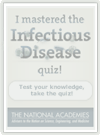
Place this badge on your Facebook page to show your friends what you know about infectious disease.
OR, get a higher score to unlock a different badge.
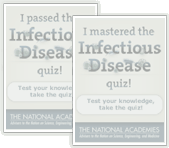
Explore Other Topics
Disease Watchlist
Infectious Disease Defined
- Chromosome
An organized structure of DNA and proteins within the nucleus of a cell that contains many genes.
